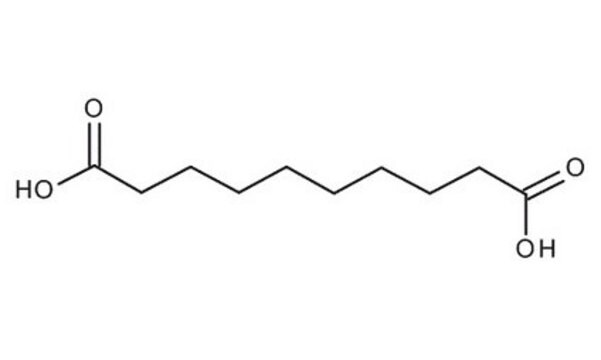283258
Sebacic acid
99%
Sinónimos:
Decanedioic acid
About This Item
Productos recomendados
presión de vapor
1 mmHg ( 183 °C)
Nivel de calidad
Análisis
99%
bp
294.5 °C/100 mmHg (lit.)
mp
133-137 °C (lit.)
solubilidad
ethanol: 100 mg/mL
ketones and ethers: soluble
cadena SMILES
OC(=O)CCCCCCCCC(O)=O
InChI
1S/C10H18O4/c11-9(12)7-5-3-1-2-4-6-8-10(13)14/h1-8H2,(H,11,12)(H,13,14)
Clave InChI
CXMXRPHRNRROMY-UHFFFAOYSA-N
¿Está buscando productos similares? Visita Guía de comparación de productos
Descripción general
Aplicación
- biodegradable and elastomeric polyesters [poly(glycerol sebacate)]
- novel bio-nylon, PA5.10
- novel temperature-response hydrogel based on poly(ether-ester anhydride) nanoparticle for drug-delivery applications
Código de clase de almacenamiento
11 - Combustible Solids
Clase de riesgo para el agua (WGK)
WGK 1
Punto de inflamabilidad (°F)
Not applicable
Punto de inflamabilidad (°C)
Not applicable
Equipo de protección personal
Eyeshields, Gloves, type N95 (US)
Elija entre una de las versiones más recientes:
¿Ya tiene este producto?
Encuentre la documentación para los productos que ha comprado recientemente en la Biblioteca de documentos.
Los clientes también vieron
Nuestro equipo de científicos tiene experiencia en todas las áreas de investigación: Ciencias de la vida, Ciencia de los materiales, Síntesis química, Cromatografía, Analítica y muchas otras.
Póngase en contacto con el Servicio técnico













